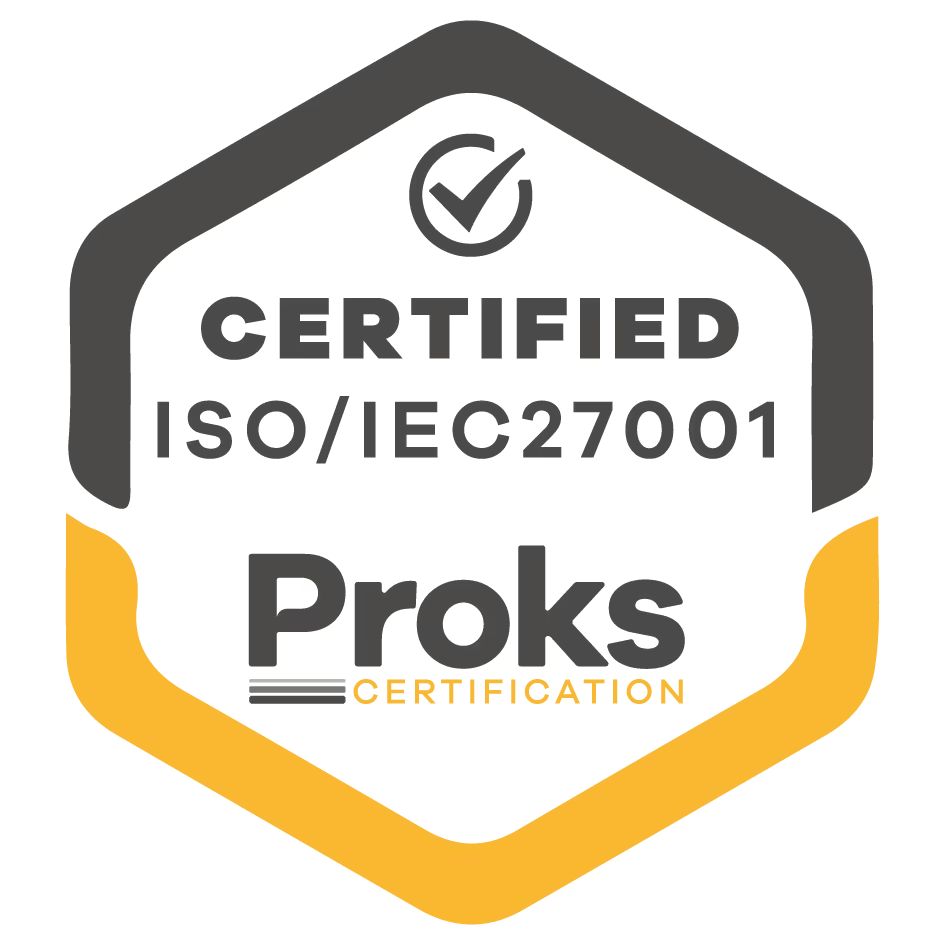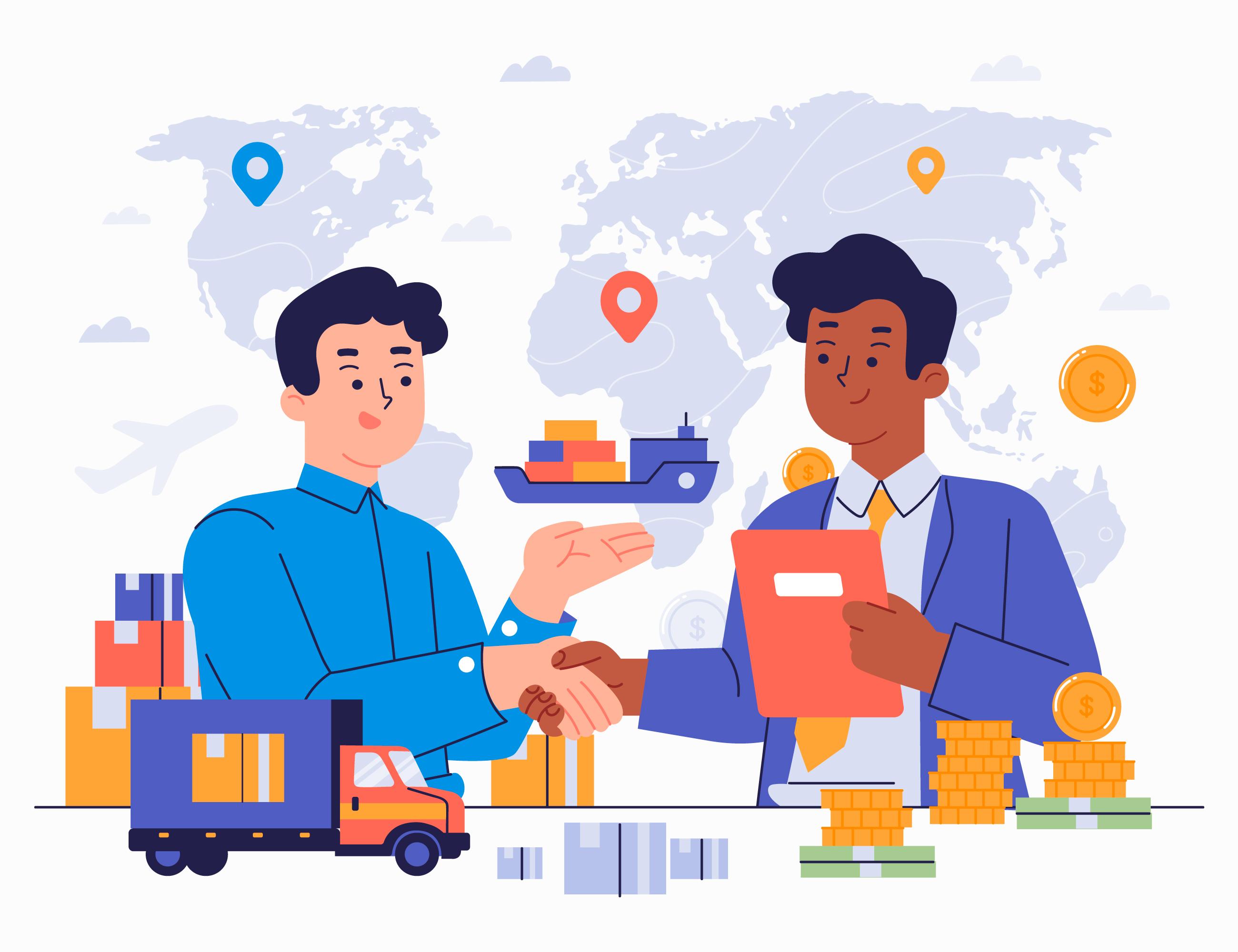

Procurement vs Purchasing: Understanding the Key Differences
Procurement and purchasing are terms often used interchangeably, but to business professionals they carry distinct meanings and implications. They might sound like two ways to describe buying supplies, but an experienced procurement officer will emphasize a world of difference between procurement vs purchasing.
Considering that external supplier costs account for about 75% of total spending (and 65% of revenue) for Fortune 500 companies, it’s critical to understand these concepts clearly.
This article will clarify the procurement vs purchasing distinction, explain the procurement and purchasing processes, highlighting their main differences, and exploring how modern technology (like e-procurement and AI) can transform both. By the end, you’ll see how strategic procurement (meaning the end-to-end management of acquiring goods and services) differs from tactical purchasing (the act of buying), and why both are essential in today’s business environment.
What Is Procurement?
Procurement is the end-to-end, strategic process of sourcing and acquiring goods or services to meet business needs. It encompasses everything from identifying what the business requires, through selecting and negotiating with suppliers, to receiving goods and managing supplier relationships. In other words, procurement covers all activities before, during, and after a purchase. It is a broad function aimed at not just buying at the best price, but also ensuring quality, reliability, compliance, and strategic alignment with company goals.
Key objectives of procurement include optimizing costs over the entire lifecycle of a product or contract, minimizing risks, and building strong supplier partnerships. Procurement in business goes beyond transactions: it’s about value creation and strategic supply management.
Steps in the Procurement Process
While every organization’s workflow can vary, a typical procurement process follows several common steps to ensure transparency and control. These steps generally include:
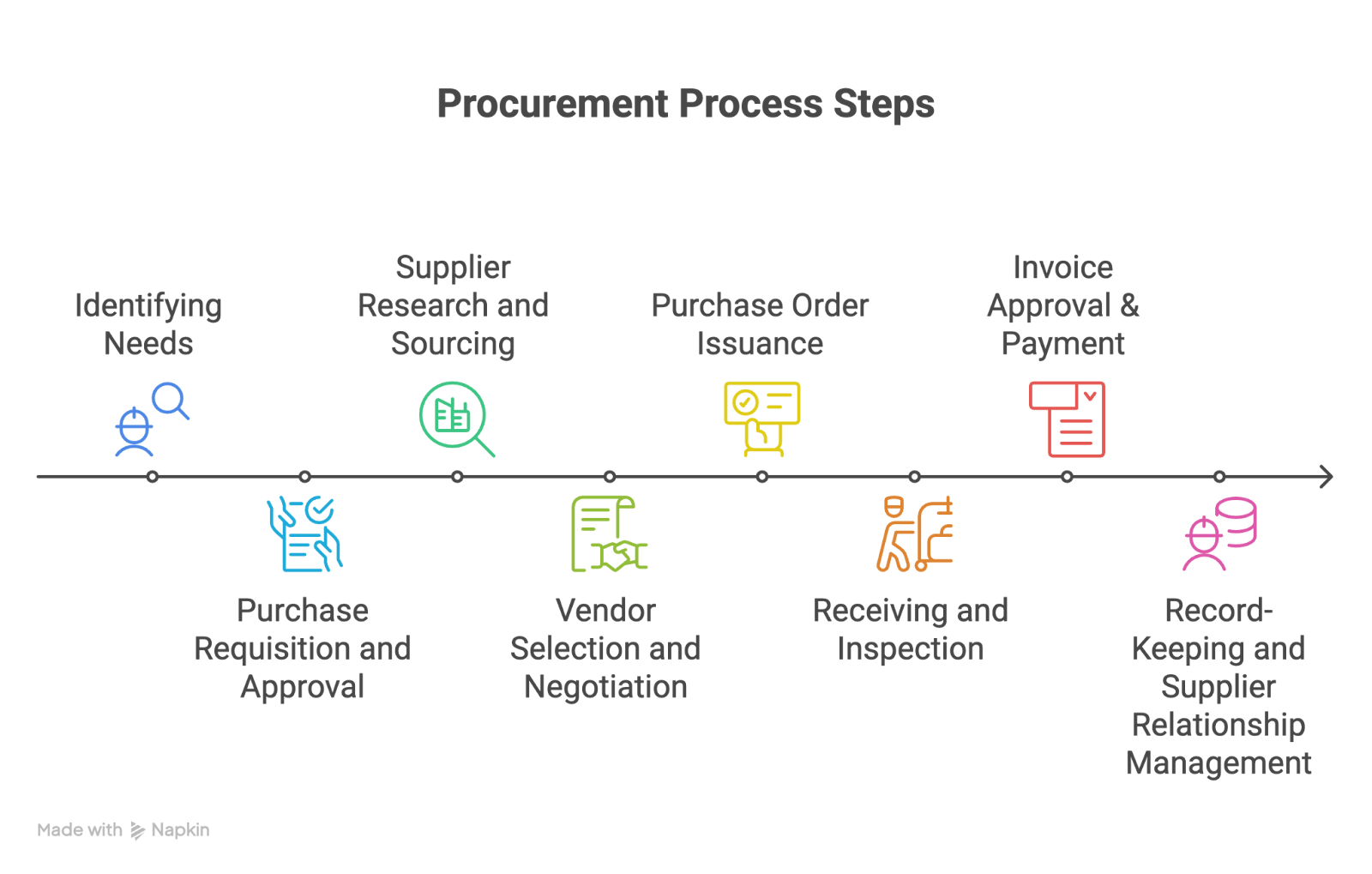
1. Identifying Needs
This implies recognizing and validating what goods or services the business requires. This often involves internal departments forecasting demand or raising requests for specific needs.
2. Purchase Requisition and Approval
The requesting department submits a purchase requisition (an internal request to buy something), which must be reviewed and approved by the procurement team, either by appropriate managers or budget owners to confirm the need and budget alignment.
3. Supplier Research and Sourcing
Procurement conducts strategic sourcing to find potential suppliers. This may involve surveying the market, creating a list of approved vendors, and soliciting bids or quotes (RFQs/RFPs) from suppliers. Vendors are evaluated on criteria such as price, quality, reliability, and compliance.
4. Vendor Selection and Negotiation
The procurement team selects the best supplier based on the bids and enters negotiations. They negotiate terms of the deal including pricing, delivery schedules, service levels, and contract clauses to secure favorable terms. A formal contract is then signed with the chosen vendor.
5. Purchase Order Issuance
Once a contract or agreement is in place, a purchase order (PO) is created and sent to the supplier to order the goods or services. The PO confirms the specifics of the purchase (item, quantity, price, delivery date) and, when accepted by the supplier, becomes a binding agreement.
6. Receiving and Inspection
The ordered goods or services are delivered. The company receives them and checks that the delivery meets the order specifications (correct item, quantity, quality, etc.). Any issues or discrepancies are noted and communicated back to the supplier for resolution.
7. Invoice Approval & Payment
The supplier submits an invoice for the delivered goods or services. The procurement or accounts payable team matches the invoice against the PO and delivery receipt (three-way match) to ensure consistency. Once verified, the invoice is approved for payment according to the agreed payment terms.
8. Record-Keeping and Supplier Relationship Management
All relevant records (contracts, POs, invoices, communications) are documented for auditing and analysis. Beyond the transaction, procurement continues to manage the supplier relationship by monitoring performance, addressing any issues, and maintaining a partnership for future needs. This can include regular evaluations and discussions for continuous improvement.
What Is Purchasing?
Purchasing is the subset of procurement that deals with the actual transaction of buying goods or services. In simple terms, purchasing is the act of acquiring what the company needs, once the preliminary work (sourcing and selecting a supplier) is done. It is a narrower, more transactional process focused on placing orders, receiving goods, and making payments.
Purchasing includes tasks like generating purchase orders, receiving deliveries, processing invoices, and ensuring suppliers are paid on time. Purchasing doesn’t typically involve higher-level activities like vendor negotiations or long-term planning. Instead, it is about following established procedures to buy the right item at the right price and time. In many organizations, purchasing is handled by a purchasing department or buyer who works within the framework set by procurement.
In essence, purchasing means fulfilling authorized buying transactions, a critical function to keep procurement operations running, but one that operates within the guidelines (approved suppliers, budgets, terms) established by the procurement strategy.
Steps in the Purchasing Process
The purchasing process is more narrowly focused than procurement and deals with the steps required to request, order, receive, and pay for goods or services. Common steps in the purchasing cycle include:
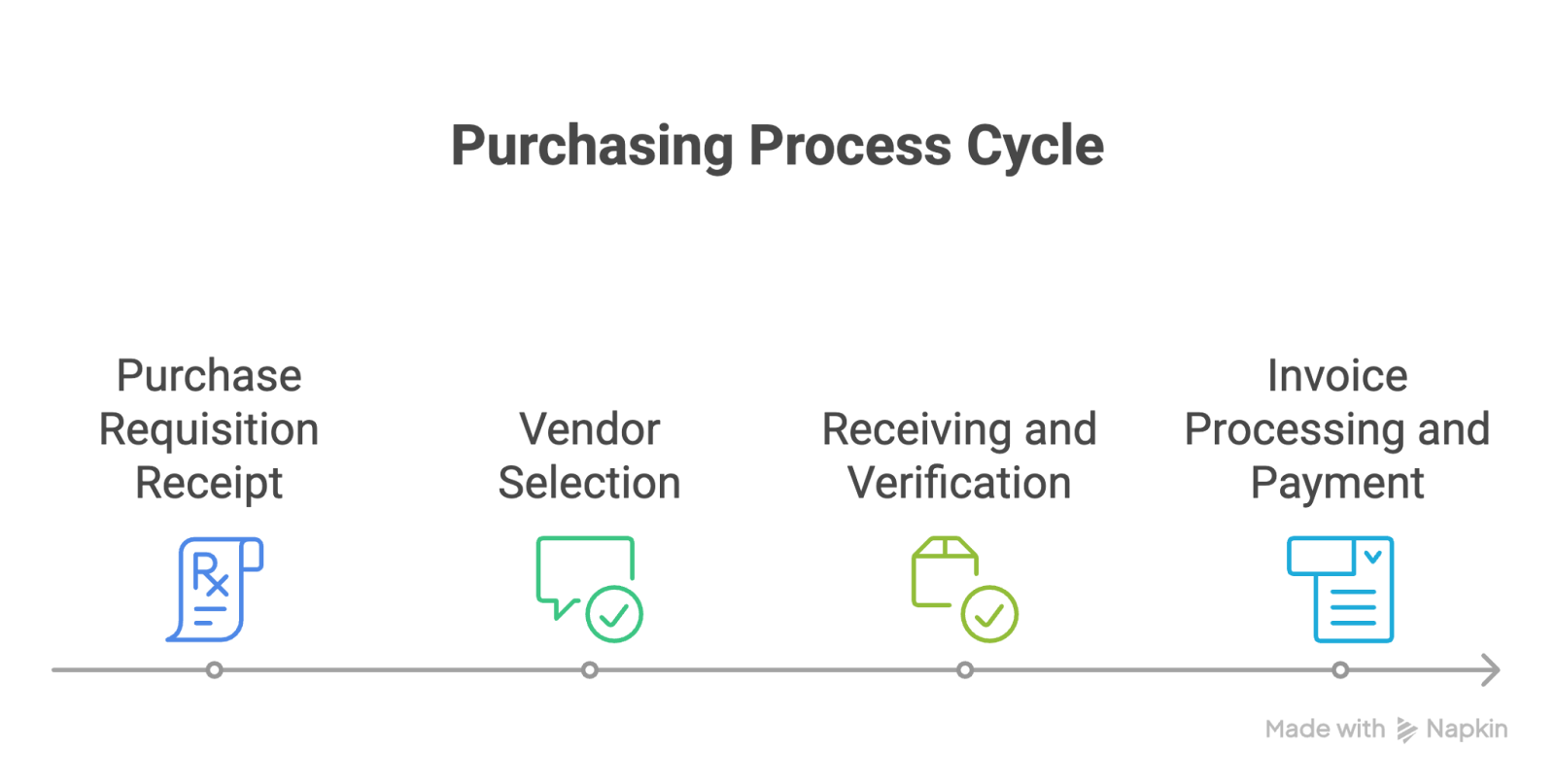
1. Purchase Requisition Receipt
The process begins when a purchase requisition (PR) is received by the purchasing team or a buyer. This requisition is an internal document or request from an employee or department, specifying what needs to be purchased. The purchasing team verifies the PR is properly approved and complete.
2. Vendor Selection
At this stage, the purchasing department assesses the quotes received from suppliers and evaluates which is the best option based on quality, price, delivery terms, contract terms, and further criteria. A vendor is then selected and a formal PO is issued to the chosen supplier.
3. Receiving and Verification
When the supplier delivers the order, the receiving department (or the requester) checks the shipment or service against the purchase order. They verify the quantity and quality, ensuring everything received matches what was ordered (this is where any receiving documents are matched with the PO). If something is damaged or missing, the purchasing team will expedite a solution with the supplier.
4. Invoice Processing and Payment
The supplier’s invoice is compared against the PO to confirm that the company was billed correctly for what was received. After resolving any discrepancies, payment is issued to the supplier as per the payment terms (completing the purchasing cycle).
Main Differences Between Procurement vs. Purchasing
Although procurement and purchasing are closely related and work hand-in-hand, there are clear differences in their scope, focus, and approach. Below are some of the main distinctions when comparing purchasing vs procurement:
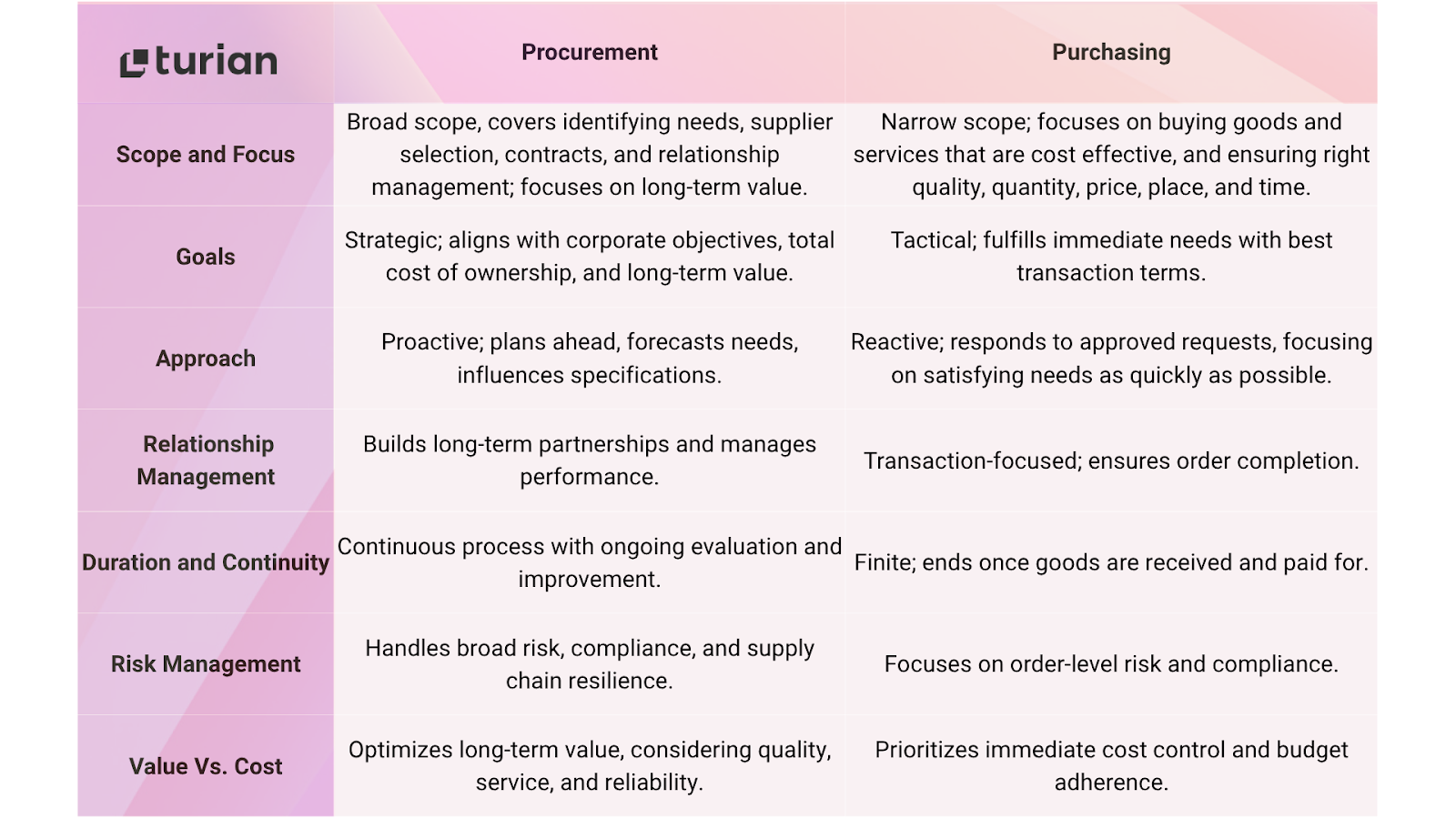
Source: turian
Scope and Focus
Procurement has a broader scope: it includes everything from identifying business needs through supplier selection, contracting, and post-purchase relationship management. The focus of procurement is on maximizing long-term value for the organization, including cost savings, quality improvement, and risk reduction. Purchasing, in contrast, is narrower in scope, dealing with the execution of orders. Its focus is on the transaction itself: buying the goods/services that are cost effective, adhering to budgets and ensuring the five rights (right quality, quantity, price, place, time) for each order.
Strategic vs. Tactical Goals
The goal of procurement is strategic: aligning purchases with corporate objectives and looking at the total cost of ownership and value over time. Procurement decisions consider how a supplier or contract can support business strategy, competitive advantage, and innovation. On the other hand, purchasing is tactical and operational. The goal of purchasing is to fulfill immediate requirements with the best possible transaction terms.
Proactive vs. Reactive
Procurement tends to be proactive. Procurement professionals engage in planning, working with departments to forecast needs, analyze the market, and prepare sourcing plans in advance. They might even influence product design or specifications by providing market insights early. Purchasing is more reactive, it kicks in once a need is identified. A purchaser reacts to an approved request by placing an order to satisfy that need as quickly as possible. In short, procurement tries to anticipate needs and shape terms ahead of time, while purchasing responds to needs at the moment they arise.
Relationship Management
A key difference is in managing supplier relationships. Procurement involves building and maintaining long-term relationships with suppliers. Procurement officers may work closely with key suppliers to negotiate better terms, foster collaboration, and ensure mutual benefits over time. Supplier relationship management (SRM) is often a procurement function. Purchasing, meanwhile, is generally transactional in its view of suppliers. During purchasing, the focus is on getting the order completed: communicating specifics like purchase orders and delivery schedules. While purchasers do interact with suppliers, it’s typically about transaction execution (expediting an order, resolving a shipment issue) rather than strategic partnership development. In practice, these roles can blur, but the emphasis differs: procurement aims for long-term partnership and performance, while purchasing emphasizes timely fulfillment of each deal.
Duration and Continuity
Procurement is an ongoing, continuous cycle. Even after a purchase is completed, procurement is evaluating supplier performance, gathering spend data, and refining strategies for the next cycle. It involves continuous improvement and adaptation to market changes or new organizational needs. Purchasing has a more finite duration: once the goods are received and paid for, that particular purchasing cycle is complete (aside from any after-the-fact recordkeeping or evaluation).
Risk Management and Complexity
Procurement typically handles broader risk management and compliance considerations. For instance, procurement will assess supplier risks and put strategies in place to mitigate them. Procurement must ensure the supply chain is resilient and complies with legislation and internal policies. Purchasing certainly plays a role in compliance (e.g. making sure the purchase follows the contract and the items meet specs), but its risk focus is narrower, mainly ensuring each order is delivered on time, meets quality standards, and that payment is processed correctly. Complex issues like ethical sourcing, long-term supply disruptions, or regulatory changes are usually handled at the procurement level.
Value vs. Cost Emphasis
Procurement emphasizes value optimization. This means looking beyond just the price tag to consider total value, and also assessing service, quality, warranty, supplier reliability, and future opportunities. A procurement team might choose a supplier who offers higher quality or better innovation even if the upfront price is slightly higher, because the long-term value is greater. Purchasing emphasizes cost control for the immediate purchase. Purchasers are often focusing on obtaining the lowest price or staying within budget. In practice, companies need both perspectives: strategic value focus to choose the right suppliers (procurement) and sharp cost focus to execute each deal efficiently (purchasing).
How to Automate Your Procurement and Purchasing Processes
Both procurement and purchasing processes involve many steps and stakeholders which can be time-consuming and inefficient if handled manually. In fact, a single purchasing cycle might stretch over weeks, and a full procurement cycle can span months (especially if multiple rounds of supplier negotiation are needed). When done with spreadsheets, emails, and paper, these processes often suffer from delays, bottlenecks, and inefficiencies. The good news is that modern technology offers ways to improve these workflows. Some options include:
E-Procurement and Digital Workflows
Generally, the first step in automation is moving from manual methods to e-procurement. E-procurement (electronic procurement) refers to using digital systems and software to handle procurement and purchasing tasks online. This includes everything from electronic purchase requisitions and approvals to online supplier catalogs, digital purchase orders, and automated invoice matching.
Companies are rapidly adopting e-procurement platforms: in 2025, retail e-commerce sales are estimated to exceed 4.3 trillion dollars globally.
Using e-procurement software or integrated procure-to-pay (P2P) systems can bring several benefits including process efficiency, as routine tasks like generating POs, obtaining approvals, and processing invoices can be automated. This speeds up processes and leads to cost savings, as e-procurement systems often include budget controls, and analytics that help companies stay within financial targets. Automating procurement also reduces errors which sometimes causes overspending. According to recent studies, AI-powered procurement solutions are expected to increase transaction speeds by up to 40% by 2025 while significantly reducing operational costs.
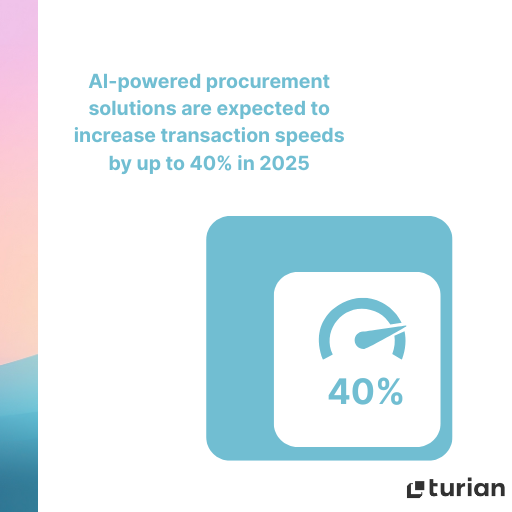
Source: made by turian, using data retrieved from Procurement Magazine.
E-commerce solutions can improve supplier management, as many tools include supplier portals where vendors can receive POs and send invoices, making the communication and collaboration with suppliers more centralized and smooth. These solutions are also great for compliance checks (ensuring suppliers have uploaded certifications or agreed to terms) as they can automatically flag any supplier risk issues.
E-procurement can transform a cumbersome paper-based process into an efficient, transparent digital workflow. Stakeholders can interact on a common platform: employees submit requests online, managers approve with a click, and suppliers receive electronic orders.
{{cta="/cta/automate-operational-procurement-with-ai-agents"}}
AI and Intelligent Automation (The Next Frontier)
Beyond standard workflow automation, the latest developments in AI, particularly generative AI and intelligent agents, are poised to revolutionize procurement and purchasing even further. Traditional procurement software automates structured tasks, but AI can tackle unstructured and complex activities that previously required human judgment. For instance, AI algorithms and large language models (LLMs) can read and understand text in contracts, emails, and purchase documents, meaning that automation can be taken a step further and technically cover all steps of procurement and purchasing processes. This does not mean AI will replace procurement and purchasing teams, but it will certainly make their work more efficient.
44% of procurement leaders consider accelerating digitalization (including AI adoption) a top priority in the short to medium-term. Why this enthusiasm? Because, as we said, AI can enhance many facets of procurement: AI can process emails and extract and process data from different kinds of procurement documents, and therefore validate POs, compare suppliers, process invoices, or handle RfQs. Based on the data extracted, it can automatically update the ERP. AI agents are also capable of analyzing contracts: extracting key data points, verifying facts and conditions, executing actions in ERP or CRM systems based on the data extracted, and much more.
In addition, purchasing work involves a lot of communication: confirming orders, asking for delivery updates, responding to supplier inquiries. All routine communication can be fully taken over by AI agents.
AI can also analyze spend data, forecast demand for materials, and even predict price fluctuations of commodities to inform buying decisions. McKinsey found that better use of data (aided by AI) can increase the pipeline of procurement value initiatives by up to 200%, meaning procurement teams can identify far more savings or improvements than before.
Compliance is one more aspect that AI can automate in procurement by monitoring data sources to flag supply chain risks or compliance issues. It can also check procurement transactions against compliance rules.
How turian Can Help You Automate Procurement and Purchasing Processes
turian provides AI agents to automate procurement and purchasing workflows end-to-end. This goes beyond the capabilities of typical e-procurement solutions. A turian AI agent can read and understand an incoming supplier email (say, an order confirmation or a clarification question), cross-reference it with the purchase order in the ERP system, take appropriate actions (update the ERP records if everything matches, or draft a message to resolve discrepancies if something is off), and even handle the communication with the supplier: all without human intervention.
Modern AI solutions like this do not require the company to invest in building complex models from scratch. AI agents powered by LLMs come with an understanding of language and context, and they can be quickly configured to a company’s workflow with minimal training data, making implementation fast and flexible.
The result is a hybrid human-AI workforce: with AI’s solution, human procurement professionals oversee the AI agents, handling only the exceptions or higher-level strategy, while the AI handles the repetitive and time-consuming portions of procurement and purchasing. As turian’s vision suggests, the future is a world where human employees oversee a team of AI agents.
This kind of agentic automation can drastically improve productivity and throughput. In early deployments, some companies have seen a 5 times increased return on investment from AI implementations in procurement, thanks to efficiency gains and error reduction. More broadly, AI in procurement is expected to drive better decisions, enhancing insights, productivity, and cost optimization, as noted by most CPOs in a Deloitte survey.

Source: Made by turian using Napkin, with data gathered from Deloitte.
The advantages are clear. Start by digitizing the process (if you haven’t already) to eliminate paper and manual spreadsheets. Then layer in AI for tasks like intelligent document processing, auto-communication, and analytics. The payoff is substantial: faster cycle times, lower operational costs, and the ability for your human team to focus on strategic activities rather than chasing paperwork.
{{cta="/cta/turn-your-inbox-into-a-supply-chain-cockpit"}}
FAQ
Purchasing refers specifically to the act of buying goods or services. It focuses on the transaction itself: placing orders, receiving products, making payments, ensuring the best price, and right quantity, time, and place. Procurement has a broader scope than purchasing. It covers everything from identifying business needs, selecting suppliers, negotiating contracts, to managing supplier relationships after the purchase. Procurement focuses on maximizing long-term value for the organization by improving cost efficiency, quality, and reducing risks.
Strategically, procurement aligns purchases with overall business goals, considering total cost of ownership and long-term value. It involves proactive planning, market analysis, and building ongoing partnerships with suppliers. Purchasing is more tactical and reactive, focusing on fulfilling immediate needs and completing transactions efficiently. While procurement manages risks, compliance, and continuous improvement, purchasing focuses on the successful completion of individual orders and cost control. Together, procurement and purchasing balance strategic value and operational execution.
Procurement involves much more than buying. It includes planning what to buy and when, analyzing market trends, selecting suppliers based on performance and reliability, and ensuring compliance with regulations and company policies. Effective procurement drives cost savings and operational efficiency by aligning purchases with the organization’s overall strategy and long-term goals. It also involves managing risks related to supplier disruptions, quality issues, and price volatility.
Automation usually begins by replacing manual tasks and paper-based documents with digital e-procurement solutions. Businesses can start by implementing software that manages purchase requests, approvals, supplier catalogs, and invoice processing online. You can also integrate these tools with existing ERP systems.
The next step in general is to move to AI-powered solutions to handle complex tasks like extracting data from contracts and emails, validating purchase orders, and automating supplier communications. With AI businesses can also monitor processes to flag compliance issues and supply chain risks.





